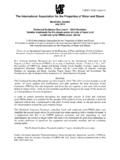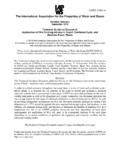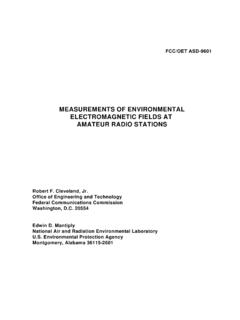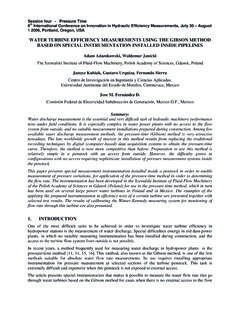Transcription of The International Association for the Properties of …
1 IAPWS TGD2-09(2015) The International Association for the Properties of Water and Steam Stockholm, Sweden July 2015 Technical Guidance Document 2015 Revision: Instrumentation for monitoring and control of cycle chemistry for the steam-water circuits of fossil-fired and combined cycle power plants 2015 International Association for the Properties of Water and Steam Publication in whole or in part is allowed in all countries provided that attribution is given to the International Association for the Properties of Water and Steam Please cite as: International Association for the Properties of Water and Steam, Technical Guidance Document: Instrumentation for monitoring and control of cycle chemistry for the steam-water circuits of fossil-fired and combined cycle power plants (2015).
2 This Technical Guidance Document has been authorized by the International Association for the Properties of Water and Steam (IAPWS) at its meeting in Stockholm, Sweden, 28 June to 3 July, 2015. The members of IAPWS are: Britain and Ireland, Canada, the Czech Republic, Germany, Japan, Russia, Scandinavia (Denmark, Finland, Norway, Sweden), and the United States of America. Associate Members are Argentina and Brazil, Australia, France, Greece, New Zealand, and Switzerland. The President at the time of adoption of this document is Dr. David Guzonas of Canada. Summary This Technical Guidance Document was first issued in 2009 and revised in 2012. This 2015 revision includes a small number of minor updates and clarifications, and adds guidance for Heat Recovery Steam Generators (HRSGs) that start frequently and those that are required to fast start with minimal delays to startup times.
3 These do not constitute significant changes to scope of the document or to the guidance contained. In order to achieve suitable chemical conditions in steam/water circuits, it is essential to establish reliable monitoring of key parameters on every plant. This enables the demonstration of operation within cycle chemistry targets, and alerts the operators to the need to take corrective action when the target conditions are compromised. This technical guidance document considers conventional fossil and combined cycle / HRSG plants and identifies the key instrumentation and monitoring techniques required for each plant type and cycle chemistry treatment. It is emphasized that this is an IAPWS guidance document and that, depending on local requirements, the use of simpler instrumentation may be adequate, whereas more complex techniques and instrumentation may be necessary when specific issues arise.
4 This Technical Guidance Document contains 25 pages, including this cover page. Further information about this Technical Guidance Document and other documents issued by IAPWS can be obtained from the Executive Secretary of IAPWS (Dr. Dooley, or from 2 Contents 1. Nomenclature and Definitions .. 3 2. introduction .. 5 3. On-line Monitoring Techniques .. 6 Key 6 Conductivity (or specific conductivity or direct conductivity) .. 6 Conductivity after cation exchange (or Cation conductivity or Acid conductivity) .. 7 pH .. 8 Dissolved Oxygen .. 9 Sodium .. 10 Phosphate (only for those drum boilers where a phosphate dosing regime is applied) .. 10 Oxidation/Reduction Potential (ORP).. 11 Optional Additional on-line Instruments .. 11 Degassed conductivity after cation exchange (Degassed cation conductivity) . 11 Silica .. 12 Total Organic Carbon .. 12 4. Circuit Locations for On-line Monitoring.)
5 13 Make-up Water .. 13 Condensate .. 14 Feedwater .. 15 Plants with condensate polishers .. 15 All Plants (with or without condensate polishers) .. 16 Drum Boiler Water/HRSG Evaporator Water .. 16 Drum boiler plants with AVT (no solid alkali being added to the drum) .. 17 Drum boiler plants with phosphate treatment .. 17 Drum boiler plants with caustic treatment .. 19 Once-through boilers .. 19 Steam .. 20 Main Steam Saturated .. 20 Main Steam Superheated and Reheated .. 21 Fast Start HRSGs .. 21 5. Off-line Batch (grab) and Confirmatory 22 6. References .. 23 31. Nomenclature and Definitions Term Alternative or Acronym Definition All-volatile Treatment AVT AVT(R) AVT(O) Conditioning regime in which only volatile alkalising agents are used (commonly ammonia volatile amines may also be employed).
6 May be either: Reducing conditions (added reducing agent) or Oxidizing conditions (residual oxygen present) Attemporator Device for controlling superheater and reheater outlet temperatures by spraying feedwater (or condensate or degassed demineralized water) into steam. Caustic Treatment CT Conditioning regime for drum boilers in which alkalinity is achieved by dosing with NaOH. Condensate Water that derives from condensation of steam after passage through a steam turbine or process heat exchanger. (Monitored at the Condensate Pump Discharge (CPD) and Condensate Polisher Outlet (CPO)) Conductivity Specific Conductivity Direct Conductivity Electrical conductivity of an unmodified water sample.[1] Conductivity after cation exchange Cation Conductivity Acid Conductivity CACE Conductivity of a water sample after passage through a strongly acidic cation exchanger in the hydrogen form. Degassed conductivity after cation exchange Degassed Cation Conductivity.
7 DCACE Conductivity after cation exchange of a sample from which volatile weak acids (predominantly carbonic acid) have been stripped. Drum boiler Boiler in which steam (generated in heated evaporator tubes) is separated from water in a horizontal pressure vessel. The liquid phase is recirculated to the evaporator. Fast Start Combined Cycle / HRSG Plant Combined cycle plant able to have accelerated hot, warm and cold starts. Feedwater Water that is being pumped into a boiler or HRSG to balance the steam production. 4 Term Alternative or Acronym Definition Heat Recovery Steam Generator HRSG Plant that generates steam using heat from the exhaust gas of a combustion (gas) turbine. Make-up Water Water which is added to compensate for losses of water and steam from the system. Once-through boiler or HRSG Benson Boiler Boiler in which output steam is generated from input water by evaporation to dryness without recirculation.
8 Oxidation/Reduction Potential ORP Electrochemical potential of an inert electrode responding to the concentrations of oxidizing and reducing agents in a water sample. Oxygenated Treatment OT or CWT Conditioning regime in which alkalizing agents and oxygen are added. (OT = oxygenated treatment, CWT = combined water treatment) Phosphate Treatment PT Conditioning regime for drum boilers in which alkalinity is achieved by dosing a sodium phosphate compound or blend of compounds. Total Organic Carbon TOC Concentration in aqueous solution of the carbon present in organic molecules and ions. (Excludes carbon present in carbonates, bicarbonates and other inorganic species.) 52. introduction Safe, reliable operation of large steam raising and power generating plants depends upon the establishment of chemical conditions throughout the steam-water circuit that minimize the corrosion of system components and suppress the formation of deposits.
9 The chosen chemical treatments and instrumentation will depend upon the details of plant type, circuit design, metallurgy, physical parameters (temperatures, pressures, heat fluxes, etc.) and intended operational mode of the plant (base, medium or peak load operation, frequent starts, and HRSGs that are required to fast start after different shutdown periods). In all cases, it is essential to be able to measure the key chemical parameters and to take action on the basis of these measurements to ensure that chemical targets are achieved. This technical guidance document considers conventional fossil and combined cycle/HRSG plants and identifies the key instrumentation and monitoring techniques required for each plant type and cycle chemistry treatment. Thus, for all systems there is a Minimum Key Level of Instrumentation. The document also considers Optional Additional Instruments, not essential for all plants, but which may provide further useful information to plant operators.
10 Particularly important cases are for the combined cycle / HRSG plants that are required to fast start and to frequently cycle (or two-shift). As an example, during fast start situations a combined cycle plant could be required to reach full load from gas turbine (GT) ignition in under 30 minutes following a unit shutdown of eight hours or less. This IAPWS document provides guidance on how best to monitor steam purity to demonstrate that it is suitable for admission to the steam turbine with minimal delays to startup times and, additionally, how best to set up on-line monitoring to detect serious cycle contamination during startups. The document represents the accumulated experience of the IAPWS Power Cycle Chemistry (PCC) Working Group with representation from 21 countries. It is important that the operators of a plant consider the following items in developing a Minimum Key Level of Instrumentation: 1.













